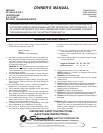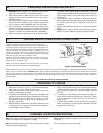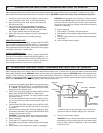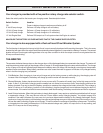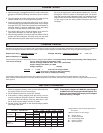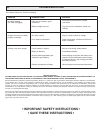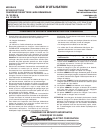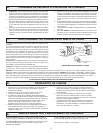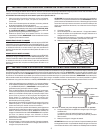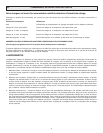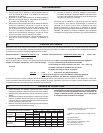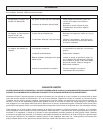
4
OUTPUT SELECTOR CONTROLSH.
Your charger is provided with a five position rotary charge rate selector switch.
Select the switch position that meets your charging needs. See description below.
Switch Position Used for
Off Power to battery charger transformer and battery is off.
6 Volt 30 amp charge Delivers a 30 amp charge to a 6 volt battery.
12 Volt 10 amp charge Delivers a 10 amp charge to a 12 volt battery.
12 Volt 30 amp charge Delivers a 30 amp charge to a 12 volt battery.
12 Volt Engine Start Delivers 200 amps to a 12 volt system when the Engine is cranked.
MAKE SURE THE BATTERY VOLTAGE MATCHES THAT OF THE CHARGE RATE SELECTED.
Your charger is also equipped with a
Dual self reset Circuit Breaker System.
The first breaker is designed to interrupt a high flow of current normally developed while cranking the engine. This is the same
breaker that will open when the output leads are accidentally shorted together or connected to a battery in reverse. The second
breaker will open if prolonged cranking persists or for any other condition in which the output current is much greater than the
30 amp continuous rating.
THE AMMETER
The ammeter indicates the amp draw on the charger when a fully discharged battery is connected to the charger. The meter will
read the maximum output rating of the charger, either 10 amps, or 30 amps depending on the amp switch selection. The charge
on the 10 amp or 30 amp will gradually taper down as the battery nears full charge. As the charge current tapers, the ammeter
needle will also move down. Many battery conditions can also cause the meter to appear to indicate a fully charged battery
when in fact the charging has just started.
1. Cold Batteries- Start charging at a low rate of charge and as the battery warms up while charging, the charging rate will
increase. After this happens, the battery will charge up and the meter will decrease normally.
2. Shorted Batteries- (battery has shorted circuit in one or more cells) The meter will usually “peg” at the high amp end of the
scale. If after 5-10 minutes of charging and the needle has not started to move down scale, stop charging and have the
battery checked. One way to check the battery, would be to measure the voltage at the battery terminals. If the voltage is
below 12 volts on a 12 volt battery, (under 6 on a 6 volt battery), plug the charger back in and resume charging for about 15
more minutes. If the meter has failed to move towards a lower scale reading, the battery needs to be serviced or replaced.
3. Lead-Calcium batteries- When this type battery is deeply discharged, it may require an activation period before it will accept
a measurable charge. (This may take as much as 6 hours before normal charging begins). You should suspect this
condition if the meter indicates at or near zero, but you have determined the battery is very deeply discharged. Simply
continue to charge the battery until the battery becomes activated(keep an eye on the charge every 20 minutes or so) you
will see the meter indicating a higher rate of charge. This will be when the recharge of the battery commences. The battery
is charged when the meter indicates about 1/2 of the selected charge rate. (about 4-5 amps on the 10 amp setting, and
about 10-15 amps on the 30 amp setting).



